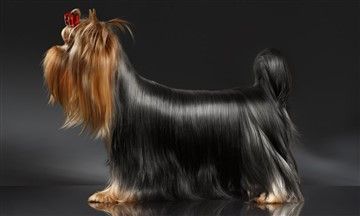Yorkshire Terrier Tail Docking
Overview
- Countries which allow this & countries that ban this
- Reasons you should or should not have this procedure done
- What docking actually is, when and how this is done
- The difference in appearance between a Yorkie tail that is docked VS one which is not


The Yorkshire Terrier has its tail docked, per AKC official breed standard conformation.
In many other countries, this practice has been banned.
Counties That Dock a Yorkshire Terrier's Tail & Counties That Do Not
Countries where it is legal to dock a Yorkshire Terrier include:
Bolivia
Canada (but the Canadian Veterinary Medical Association opposes all docking practices)
Costa Rica
Czech Republic
Egypt
France
India
Indonesia
Iran
Japan
Kuwait
Lebanon
Malaysia
Morocco
Mauritius
Mexico
Nepal
New Zealand (can only be done to puppies less than 4 days old)
Peru
Philippines
Portugal
Sri Lanka
Taiwan
Thailand
Tunisia
Unites States*
* Currently in the US, only two states have provisions regarding tail docking. In Pennsylvania, it cannot be done without anesthesia on a puppy over the age of 5 days old; however, if a dog is at least 12 weeks old, it may be done under anesthesia. Between the age of 5 days and 12 weeks, it can only be done if a licensed veterinarian deems it medically necessary. In Maryland, docking must be performed using anesthesia.
Countries where tail docking is banned and you cannot legally dock a Yorkshire Terrier's tail:
Reasons to Dock the Tail or Keep it Natural

Beau, 10 months, with a natural tail | Photo courtesy of The Stewarts
Aesthetic purposes only:
A note about a natural tail as a communication method:
A dog's tail is a remarkable tool for communication, expressing a wide range of emotions and intentions. From wagging vigorously in sheer joy to tucking under in fear, the movements of a dog's tail can convey their feelings and attitudes with astonishing clarity. It serves as a barometer of their inner state, offering insights into whether they're feeling friendly, anxious, or even aggressive. The position and motion of the tail can tell us much about what a dog is thinking and feeling, facilitating a deeper understanding and connection between canines and their human companions.
Docking a dog's tail, however, can impact this vital mode of communication. Without a full tail to express themselves, dogs may find it challenging to convey their emotions and intentions to other dogs and to people. This can lead to misunderstandings and confusion in social interactions with other dogs, who rely heavily on tail signals to interpret each other's behavior.
For humans, interpreting a docked dog's mood and intentions can also become more difficult, potentially hindering the bond between pet and pet parent. Docking can detract from a dog's ability to communicate effectively, emphasizing the importance of considering the natural ways dogs express themselves through their tails.
The Docking Procedure
Option 2: Surgical Procedure. The procedure typically involves the use of surgical scissors or a scalpel by a veterinarian and is traditionally performed between 2 to 5 days old, often without anesthesia. This practice is based, in part, on a controversial belief that puppies' nervous systems are not fully developed, potentially minimizing the pain experienced during the procedure. However, it's important to note that the assertion about puppies' nervous systems not being fully developed and their capacity to feel pain is contentious among veterinary professionals and animal welfare advocates.
In addition, the choice not to use anesthesia is due to the associated risks in very young puppies, where the potential complications from anesthesia are considered greater than the procedure's brief discomfort.
Late Age Docking: If tail docking is not performed in the early days after birth, it is often advised to wait until the puppy is older than 10 weeks. At this stage, the procedure would be carried out under anesthesia to manage pain. This delayed procedure is considered more complex and is classified as major surgery, involving a longer and more challenging recovery period.
In adult Yorkshire Terriers, tail docking might be necessary due to severe trauma or injury to the tail, such as being caught in a door. In these cases, the procedure is performed under anesthesia to ensure the dog's comfort and safety.
Do you have your book?
- 24 Yorkie Behavior Issues
- 34 Yorkie Health Issues
- INCREDIBLY helpful Socialization chapter
- Newborn to Senior Years - DETAILED care
- The most comprehensive, helpful Yorkshire Terrier book that exists.
- Now in both print and eBook formats
